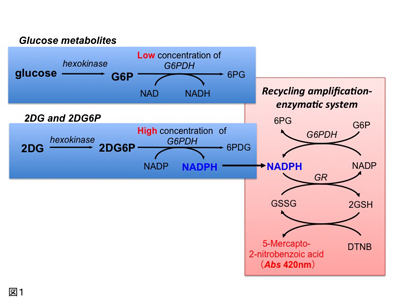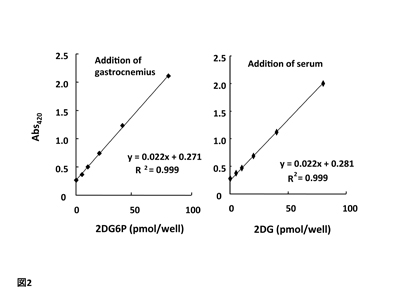Radioisotope (RI)-labeled 2DG is used for the measurement of 2DG uptake both in vivo and in vitro. However, the RI method requires a specialized facility for handling of radioisotopes. We developed a novel non-radioisotopic method for 2DG uptake in vivo and in vitro. Small amount of 2DG is administered into animals or cultured cells, and endogenous glucose and glucose-6-phosphate (G6P) in tissues or cells is oxidized in the presence of a low concentration of G6PDH. 2DG-6-phosphate (2DG6P) accumulated in cells is then oxidized in the presence of a high concentration of G6PDH. NADPH produced from 2DG6P and G6PDH is quantified at 420 nm with the use of a recycling amplification enzymatic-photometric system. The novel enzymatic method can quantify 2DG or 2DG6P in the range of 5-80 pmol. As all enzyme reactions were performed in one 96-well microplate by the sequential addition of reagents, this method can be adopted for an industrial robot. This method is thus useful for the screening of anti-diabetic drugs as well as in the research area of glucose metabolism and insulin signaling. In collaboration with our laboratory, a 2DG-assay kit based on this method is now commercially available in CosmoBio Co. Ltd.
Saito K, Lee S, Shiuchi T, Toda C, Kamijo M, Inagaki-Ohara K, Okamoto S, Minokoshi Y. An enzymatic photometric assay for 2-deoxyglucose uptake in insulin-responsive tissues and 3T3-L1 adipocytes. Analytical Biochemistry 412: 9-17 (2011).
Principle of the non-radioisotopic assay for the measurement of 2DG uptake.

Standard curve for 2DG or 2DG6P in the presence of gastrocnemius muscle lysate or serum.
